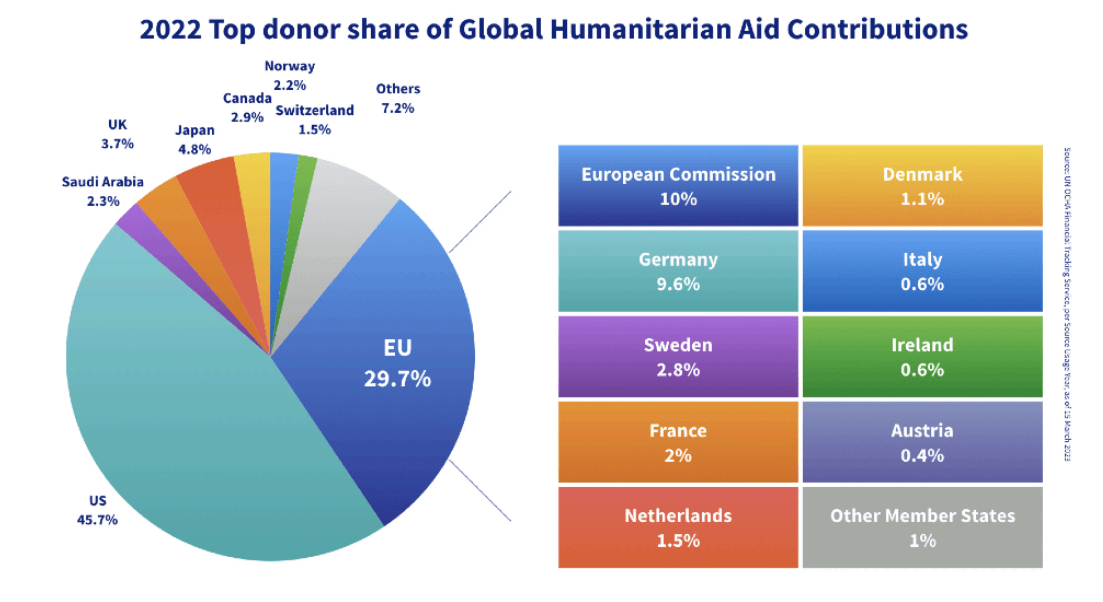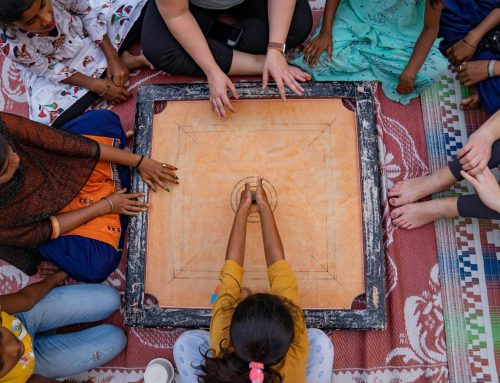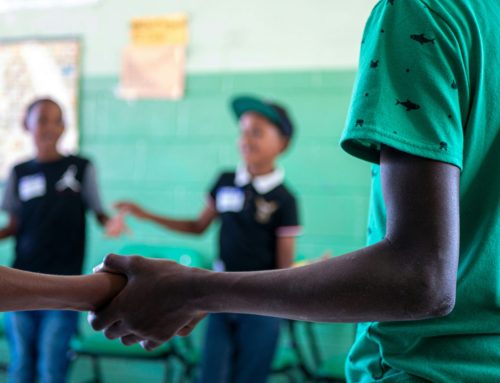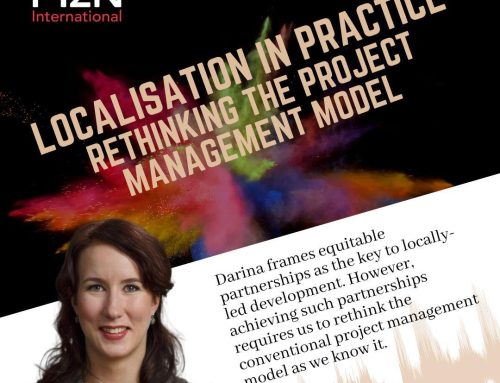Takeaways from the European Humanitarian Forum panel discussion on engaging emerging donors and new sources of financing.

Panelists from left to right: Per Heggenes CEO, IKEA Foundation, Ute Maria Klamart Deputy Executive Director for Partnerships & Advocacy, World Food Programme, Abdullah Abdulaziz Al Rabeeah Supervisor of the King Salman Humanitarian Aid & Relief Center, Diana Jansa State Secretary for International Development Cooperation, Jan Egeland Secretary General, Norwegian Refugee Council, Anya Sitaram Moderator EHF © European Commission, 2023.
“The 10 largest donors of humanitarian existence provide over 80% of the funding” was among the opening remarks of this debate. How do we widen this pool, bringing not just emerging donors, but financial institutions and the private sector to the table? This was the topic at hand, aiming to identify alternative solutions to soaring needs and limited resources in the humanitarian sector.
2022 Top 10 Donor Share of Global Humanitarian Aid Contributions

The panel wasted no time sharing their opinion on how to address the issue, presenting alternative solutions for engaging new donors and sourcing financing. Read on as we outline some of the novel perspectives:
Stimulating collective engagement:
Diana Jansa, State Secretary for International Development Cooperation, Swedish Ministry for Foreign Affairs, gave her insight on how to engage more donors:
- “Reach out to friends and partners in Asia & Latin America, especially the G20 and OECD countries, as they have the financial means to step up. It is not sustainable for the top 10 donors to provide more than 80% of the funding”.
- “Intensify dialogue with development actors & financial institutions”
- “Scale anticipatory action, especially in fragile & conflict-affected countries with high climate vulnerabilities. Only 12% of multilateral climate funding goes to fragile & conflict-affected states”.

Diana Jansa, State Secretary for International Development Cooperation, Swedish Ministry for Foreign Affairs speaking at EHF © European Commission, 2023.
Addressing the funding gap:
Jan Egeland Secretary General, Norwegian Refugee Council offered his perspective on this issue
“50% of all humanitarian needs come from one donor- the United States. We are relying on a vote in the US Congress to avoid having a free fall in the humanitarian world. That is the reality”
Jan offered the following solutions:
- More firm responsibility sharing: “There’s not only 10 strong economies in the world, there are 50-60 really strong economies. We need to call out those who are not sharing the burden”. To highlight the strength that these states have, he raised the point that “If the 50-60 countries in the high-income category of the World Bank shared the cost for 100% funding of all humanitarian needs, it would be 0.0320 of GDP” (per country).
- Provide predictable funding year on year: “We need to understand that more than 30% of emergencies are so protracted that it is ridiculous to deal with them with short-term funding annually. The large IFIs need to come up with a plan for 5 to 7 years and provide predictable funding year on year. This is the way forward for improving livelihoods and durable solutions”.
- Rethink the approach to conflict resolution “We need to lead proper renegotiation and conflict diplomacy. The EU needs humanitarian exemptions to sanctions in conflict-affected states. This is holding us back from getting new donors and the private sector involved in conflict-affected states”.

Jan Egeland Secretary General, Norwegian Refugee Council speaking at EHF © European Commission, 2023.
Engaging with national governments – WFP working example
Ute Maria Klamart Deputy Executive Director for Partnerships & Advocacy, World Food Programme expressed why national governments are key actors:
- Put national governments in the driver’s seat: “The business model of engaging with national governments should be to put the national governments in the centre, giving them ownership to drive the agenda” The following examples were given by Ute:
- Haiti and Somalia have decided to use IMF & World Bank money, and Afghanistan is using IFI World Bank money. “These resources are part of the new diversification pathway. The IFI are engaging with the national governments to deal with the food security issue. National governments have to make decisions to build systems that break the vicious cycle of food distribution and invest in social protection systems and cash-based transfers”.
- “Long-standing donors have the political responsibilities to speak with national governments & recall the SDG agenda as their responsibility, and invest into climate change resilient infrastructure”.
- Bring down operational costs: “Strive for the best innovative solutions such as; airdrops, blockchain for truck fleet management and cash-based transfers, and we need the private sector on this. Are we not clear enough? Can you help us bring down operating costs and promote innovative solutions?” She asked Per CEO of IKEA Foundation (see image)

Ute Maria Klamart Deputy Executive Director for Partnerships & Advocacy, World Food Programme speaking at EHF © European Commission, 2023.
Unlocking private sector capital in the humanitarian field
Per Heggenes’ perspective, CEO, IKEA Foundation.
- Unleashing the Power of the Private Sector: Driving Economic Growth in Fragile States. “The least effective thing you could do with the private sector is to ask them for a cheque”.”The private sector should be engaged for their ingenuity, entrepreneurship, network, and importantly their ability to create jobs and create economic development. Fragile states are in need of economic development, there is the need to invest economically to give the possibility for people to lift themselves out of poverty. Speak the language of the private sector in order to be able to engage with them and work together. That dialogue is not happening.
-
De-Risking investments for the private sector:“We need to come together and de-risk investments for the private sector in these fragile states, which will in turn drive development in those areas. This is a cheaper financing source than continuing to funnel humanitarian funding year after year into the fragile states”. The following examples were highlighted:

Per Heggenes’ perspective, CEO, IKEA Foundation, speaking at EHF © European Commission, 2023.
- UNHCR: Green Financing Initiative. Establish a facility to green every op all over the world.
- WEF: Humanitarian Resilience Investment Initiative: match development projects in the humanitarian sector with investors.
We need to create a system that scales these examples to the millions instead of the thousands. Get more private capital in to create something that would have otherwise not have happened.
To recap
The current funding gap in humanitarian aid is not sustainable, and we need to explore new ways of financing. Many familiar, and some novel, perspectives were shared on how to engage emerging donors and new sources of financing. Calling out the 40 strong economies that are not sharing the burden, promoting more firm responsibility sharing, intensifying dialogue with development actors and financial institutions, and unlocking the potential of the private sector are just some of the solutions offered by the panellists. Let us hope that we can build tangible action from this conversation and avoid repeating the same panel discussion in 10 years’ time.




